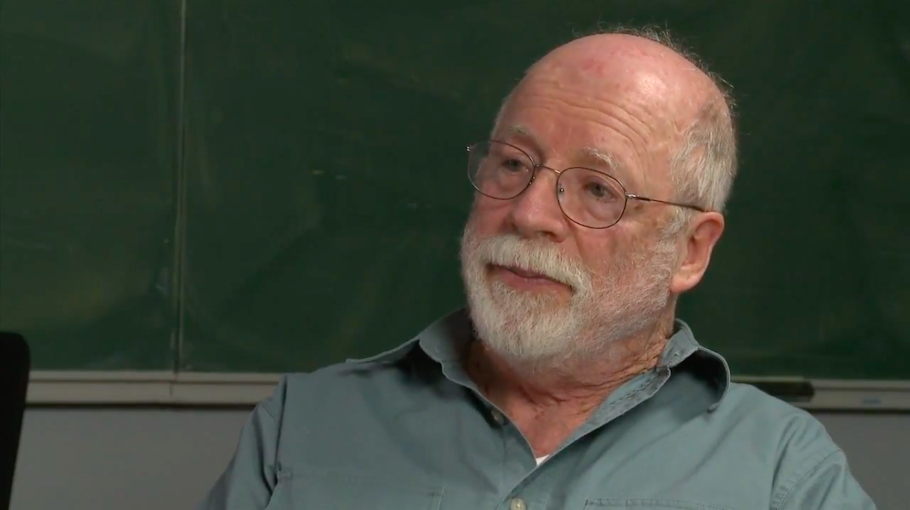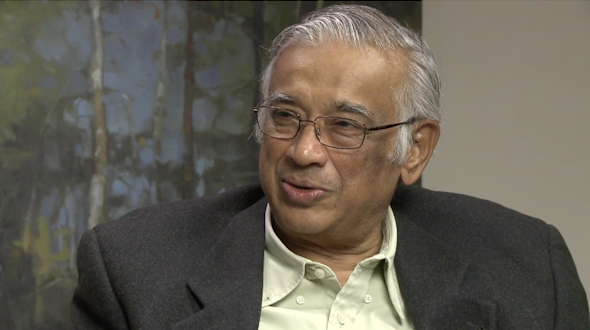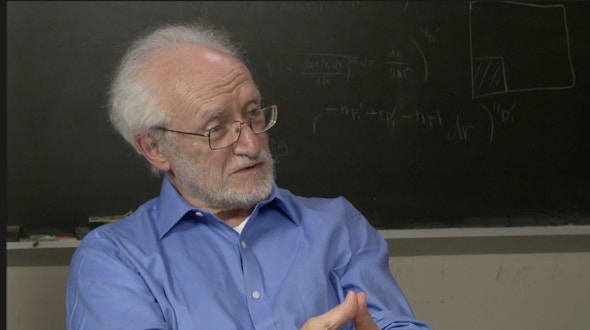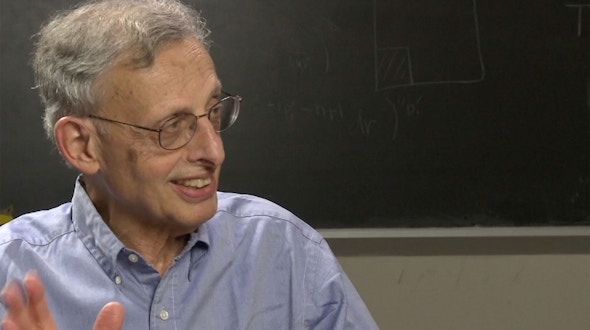Robion Kirby
- Highlights (2:37)
- Family History (9:15)
- K-12 Education (2:33)
- An Undergraduate at the University of Chicago (4:20)
- Playing Chess (5:27)
- Being a Graduate Student (8:42)
- Focusing on Topological Manifolds (3:26)
- The Annulus Conjecture (5:33)
- My Style of Working (3:25)
- The Torus Trick (10:23)
- Collaboration with Siebenmann on 3 1/2 Milnor Problems (5:10)
- The 3-Handle Counterexample (3:23)
- Promotion at UCLA (1:33)
- Luck and Mathematical Progress (1:24)
- K3 Surfaces and Kirby Calculus (7:48)
- A Few Oddball Characters (1:37)
- Fifty-Three Students and Problem Lists (6:47)
- Open Access to Journals (9:09)
- 2-Morse Functions: Work With David Gay (4:14)
- Collaboration with Paul Melvin and Selman Akbulut (2:26)
- Celebratio Mathematica (4:23)
- The Changing World for Grad Students (4:53)
In 1963, rising mathematical star John Milnor set forth a list of what he considered the seven hardest and most important problems in the nascent field of geometric topology. Just five years later, no fewer than four of those problems had been laid to rest, largely through the efforts of a young mathematics professor whose entry into mathematics research had seemed anything but auspicious. Described by colleagues and students as “slow,” “non-threatening,” and “deliberate,” Robion Kirby had followed a desultory path through higher education, marked by failed exams, lost fellowships and recommendations that he go study somewhere else. Yet just three years out of graduate school, he pulled off a mathematical coup, one that helped define the future of his field.
“I sometimes felt like the Virgin Mary,” Kirby says. “How could this happen to me?”
•••
As a child, Kirby was always ahead of his classmates academically, and he was usually allowed to read at the back of the classroom. As a result, he developed what became a lifelong habit of tuning out teachers and other authority figures. After earning a scholarship to go to the University of Chicago in 1954, he seldom attended class, instead spending his time playing chess or all-night poker games. His chess got so good that he was ranked 25th in the country at one point, but by the end of his third year of college, he was putting so little effort into his coursework that he lost his scholarship. The following year, he was not allowed to graduate because he had not passed German. “It’s very difficult to pass the oral part [of a German exam] if you’ve never gone to class and have never listened to German,” Kirby observes.
Eventually, however, Kirby discovered that “mathematics was a better game than chess,” he says. During his fifth year of undergraduate study, Kirby took six of the eight graduate courses that were required for the master’s degree in mathematics, and he parlayed this coursework into a provisional acceptance into the master’s program at Chicago, with the requirement that he improve his grades, which were hovering between B and C. Luckily, though, when his grades hadn’t budged at the end of the fall quarter, “nobody said anything,” Kirby recalls, and he proceeded to take the master’s exam, which he barely squeaked through.
The Chicago math department recommended that he transfer to a less demanding school, but Kirby chose to stay anyway and started studying algebra and topology, which focuses on the properties of a shape that don’t change when the shape gets stretched or distorted. Kirby was drawn to topology by its fascinating but accessible problems. “They were things I enjoyed chewing on,” Kirby says. “I’m more of a problem solver than a theory builder. I would never have gone into subjects where I would need to know a large amount of material — I like to get in on the ground level of something.”
Nevertheless, Kirby failed the oral qualifying exam for his doctorate.
“I had no practice at thinking on my feet,” Kirby explains. His examination committee suggested that Kirby start coming to math department tea for “picking up folklore … and just talking math,” Kirby says. He did so, and eventually he also began a daily two-person reading seminar with fellow graduate student Walter Daum. “This is where I learned a lot of geometric topology, not in classes,” Kirby recalls. “Ever since, I’ve always recommended that method of learning. … You worked things out for yourself — that’s different than listening to a lecture.”
Kirby tried his qualifying exam again, on the same two topics. “This time, they said, ‘You passed,’” he says. “They didn’t say it with any enthusiasm, but they said, ‘You passed.’” His committee recommended that Kirby move into some other field than topology.
But Kirby was not one to be deterred by discouragement from his teachers. He waited until their backs were turned, so to speak, and identified a topologist — Eldon Dyer — who had been away when Kirby took his qualifying exam. Kirby kept going to Dyer with questions, and “at some point it sort of became obvious that I was his student,” Kirby says. “And he told somebody later on that he realized at some point or other he was stuck with me.”
Kirby became interested in a topology problem known as the annulus conjecture, which asks, roughly speaking, whether the space bounded by two distorted spheres has the same topological structure no matter how distorted the spheres are. There’s a version of the conjecture for each dimension (not just the third).
It might seem obvious at first glance that the space between two distorted spheres is simply a distorted version of the space between two ordinary spheres (an “annulus”), but that is not always true if the spheres remain bumpy no matter how much you zoom in. The annulus conjecture, which Milnor included on his famous list, proposed that as long as the spheres aren’t too bumpy — as long as they are “locally flat” — the space between them is a distorted annulus.
Kirby was drawn to the annulus conjecture because it was simple enough to be understandable to someone like him who “didn’t really know much mathematics,” he says. “I could chew on this problem.”
•••
Kirby made enough progress on the annulus conjecture to graduate in 1965, and after accepting a job at the University of California, Los Angeles, he continued to mull over the problem. In August 1968, he was sitting in his apartment, minding his sleeping four-month-old son, when an idea flashed into his head — a way to prove the annulus conjecture in every dimension except four via a “torus trick” that uses the structure of a doughnut shape, or torus, to gain insight into the range of possibilities for topological distortions of ordinary space. “That was an ‘aha’ moment,” Kirby recalls.
The torus trick is “one of the simplest, most beautiful things in mathematics,” says Michael Freedman, a mathematician at Microsoft Station Q in Santa Barbara.
Kirby visited the Institute for Advanced Study in Princeton, New Jersey, for the fall quarter of 1968, and at a colloquium dinner he described his ideas to a colleague, Larry Siebenmann. Siebenmann asked him one question after another. “By the time the dinner was over, I felt he’d sucked every bit of knowledge out of my brain,” Kirby says. The two started collaborating, and by the end of the year they had used Kirby’s torus trick to settle three more of Milnor’s seven questions (again, in every dimension except four).
Kirby’s work on the torus trick propelled him to instant fame. He was promoted from assistant professor all the way to full professor at UCLA, with double the salary. And in 1971, the American Mathematical Society presented him with the Oswald Veblen Prize in Geometry, awarded once every three years for notable work in geometry or topology. In 1974, Kirby was awarded a Guggenheim Foundation fellowship.
Kirby himself modestly attributes much of this success to luck. His torus trick was perfectly timed to complete the picture for the four Milnor problems. “I got to put the last piece in the puzzle,” he says. “If I did this work earlier, I would have put in the next-to-the-last piece of the puzzle, so to speak, and somebody else would have come along and worked it out, got all the glory. We don’t talk about luck much in mathematics.”
Kirby was not content to rest on his laurels. Instead, he turned his attention to dimension four, the only one that had eluded his earlier analysis. He developed what became known as the “Kirby calculus,” a way of describing relationships between four-dimensional shapes (or “manifolds”) through surgical operations (cutting out pieces and then gluing them back in new ways) on their boundaries.
Kirby “had two huge and completely separate influences” on geometric topology, Freedman comments. After developing the torus trick, he tackled an entirely new challenge “instead of sitting around in that field and collecting all the corollaries,” Freedman says. “In that way, he has been a role model for me.”
•••
Along the way, Kirby has advised an extraordinary number of Ph.D. students — the current count is 53. Originally discouraged from studying topology, Kirby has become one of the field’s grandfathers, with literally dozens of academic grandchildren and several great-grandchildren.
Graduate students are attracted to Kirby as an adviser partly because he is so approachable, says Kevin Walker, a former Kirby student now at Microsoft Station Q. “Some people could be kind of gruff, but Rob is not like that,” Walker says. “He’s non-threatening, patient and nice. I have a really hard time recalling him ever being angry or annoyed about anything — it’s not his style.”
Kirby is “a big bear of a guy,” Freedman says. “Everyone who knows him loves him. He’s always smiling and cheerful.”
Kirby is a hands-off adviser who makes a point of not suggesting dissertation problems to his students. “A big part of research is finding your own problems,” he says. Instead, Kirby tries to convey to his students the importance of developing good mathematical taste. “Rob’s style as a mathematician is slow and deliberate,” Walker says. “He tries to get to the essence of a subject, rather than rushing headlong into technical difficulties. Rob has good instincts as a mathematician, and I learned the importance of that from him.”
Kirby’s style is famously visual and intuitive, says Paul Melvin, a former Kirby student now at Bryn Mawr College in Pennsylvania. “No matter how algebraic the subject, he always left you with a picture, which was eye-opening to me,” Melvin says. “I hadn’t thought I would do topology, but I was immediately mesmerized by his style.”
“We graduate students liked to say that Rob has two ways of proving something: sliding his left hand over his right, or sliding his right hand over his left,” Walker says.
•••
Throughout his career, Kirby has always hated writing. Yet two of his biggest contributions to mathematics have been in the realm of mathematics communication and publishing. In the mid-1970s, he compiled a list of open problems in geometric topology that influenced several generations of mathematicians in the field. In 1995, he became the first mathematician ever to receive the National Academy of Sciences Award for Scientific Reviewing, “for his list of problems in low-dimensional topology and his tireless maintenance of it.”
Starting in the mid-1990s, frustrated by the exorbitant rates charged by many mathematics journals, Kirby turned his attention to mathematical publishing. Together with Colin Rourke of the University of Warwick and several other mathematicians, Kirby created a collection of mathematics journals and eventually founded a company called Mathematical Sciences Publishers, which publishes its journals for a tiny fraction of the cost of most other math publications.
“His work in math publishing is a big part of his legacy,” Walker says. “You don’t get credit for that the way you do for a paper, but it’s a big public service.”
Kirby, who is now 75, is nominally retired, although he still pursues an active research program. He looks back on his long career with satisfaction.
“I’m not a fount of wisdom, and people don’t ask me many questions because I don’t know very much,” he says. “But someone once said about me, ‘Rob doesn’t know a lot of math, but what he does know, he knows very well.’ I’ve been lucky enough to do pretty well at math.”



